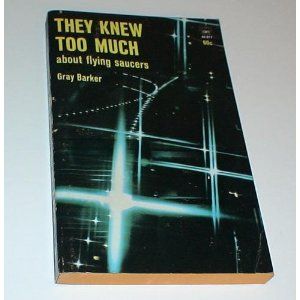Men in Black: The UFO Buff's Bogeymen
The Men in Black are said to be mysterious, dark-suited figures who contact UFO eyewitnesses and warn them not to tell anyone else about what they know. These figures typically appear in groups of three and are usually assumed to be either government agents or shape-shifting space aliens in disguise.

The origin of the Men in Black can be traced back to the early 1950s when a UFO buff named Albert Bender created a small organization, the International Flying Saucer Bureau, which published a magazine called "Space Review." In 1953, Bender claimed that he had been visited by "three men wearing dark suits" who ordered him not to continue publishing information about flying saucers. He offered no evidence of his encounter, and cynics noted that the magazine was losing money and likely would shut down soon anyway.
A decade later, Bender wrote a rambling book elaborating on his experience and suggesting that his mysterious visitors may have been extraterrestrials who didn't want their existence known. The Men in Black were not alone; according to Bender's account they were accompanied by "three beautiful women, dressed in tight white uniforms."

Bender's story got the attention of a UFO magazine publisher named Gray Barker. As folklorist James Lewis notes in his encyclopedia "UFOs and Popular Culture," "Barker considered himself an entertainer and folklorist rather than a factual reporter and was a gifted writer with a gentle, understated sense of humor. One of Barker's best friends was James W. Moseley, publisher of a rival magazine, Saucer News." Barker was an accomplished prankster and hoaxer, and together with Moseley even faked a U.S. State Department letter stating that the government had hard evidence of UFO contact and sent it to a man who claimed to have been abducted by aliens.
Barker wrote about Bender's story in his 1956 book "They Knew Too Much About Flying Saucers," and according to another colleague of Barker's, John Sherwood, in the 1960s the pair elaborated on (or further fictionalized, depending on your point of view) the claim with their own Men in Black hoax, publishing a fictional story masquerading as the true account of three dark-suited aliens who threatened UFO experts and witnesses into silence.
The Men in Black idea was accepted by many in the conspiracy-prone UFO community, partly because it seemed to legitimize the truth of eyewitness reports. No matter how outlandish their story, if an eyewitness credibly claimed that he or she had been threatened, the story seemed more plausible. After all, if the story was bogus, why would the government take an interest in the eyewitnesses, much less try to silence them? [Countdown: Top Ten Conspiracy Theories]
Later others adapted and promoted their own stories about the Men in Black, including UFO buff John Keel (in his 1975 book "The Mothman Prophecies") and Ed Solomon, screenwriter for the 1997 science fiction comedy "Men In Black," which became an international hit and spawned two sequels.
Are the stories true?
Were any of these stories true? It is of course possible that at some point dark-suited men from government agencies made inquiries into UFO reports; there was, after all, an Air Force program that investigated flying saucer claims in the 1950s called Project Blue Book. Government officials (including those with the military, police, Secret Service, FBI, or IRS, for example) are sometimes known to throw their weight around and intimidate people, even unintentionally. Of course, hoaxing a Men in Black encounter would be very simple, and require nothing more than three somber, dark-suited pranksters to menace a UFO eyewitness. [The Real Men in Black: Secret Service Agents (Infographic)]
Mysterious, authoritative, and menacing figures dressed in black are hardly unique to UFO mythology. In fact, folklore from around the world often describe such figures as representing Satan or other dark forces. Ironically, if the Men in Black do exist outside of folklore and myth, it seems that their threats are always bluffs. They have popped up in one variation or another in dozens (if not hundreds) of high-profile UFO encounters, supposedly threatening people into silence — yet the fact that the stories circulate shows that the witnesses routinely ignored the supposedly menacing Men in Black and told their stories in books, magazines, and television interviews. If the Men in Black were real — and effective at suppressing encounters with extraterrestrials — we shouldn't know about them at all.
Men in Black reports seem to have largely fallen out of fashion in recent years — perhaps because they have become something of a pop culture joke. What may have seemed menacing a half-century ago (three men in black suits accompanied by three sexy women in tight white uniforms) elicits little more than a laugh these days.
At least, that's what they want you to think.
Benjamin Radford is deputy editor of "Skeptical Inquirer" science magazine and author of six books, including "Scientific Paranormal Investigation: How to Solve Unexplained Mysteries." His website is www.BenjaminRadford.com.
Related:
Sign up for the Live Science daily newsletter now
Get the world’s most fascinating discoveries delivered straight to your inbox.

